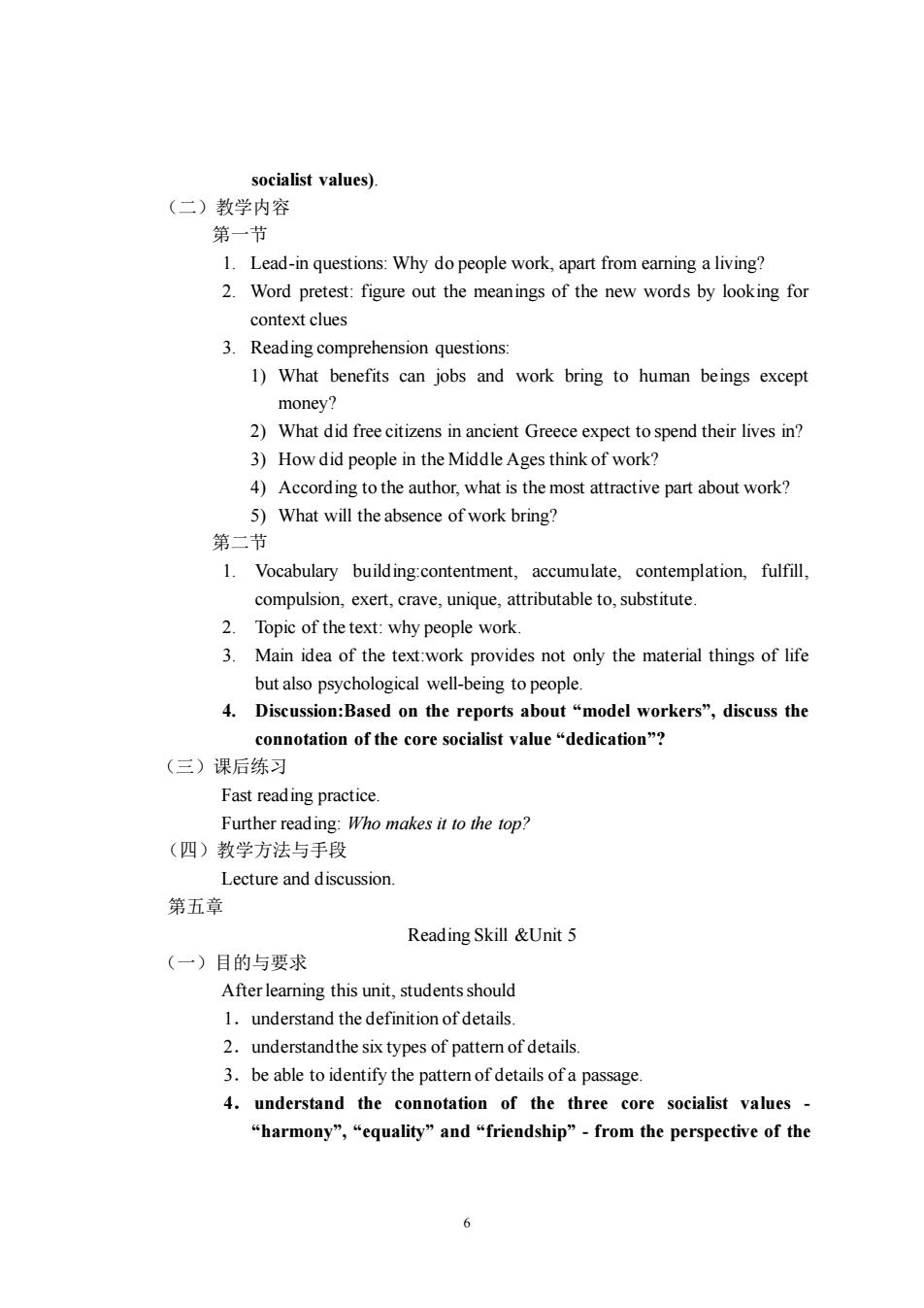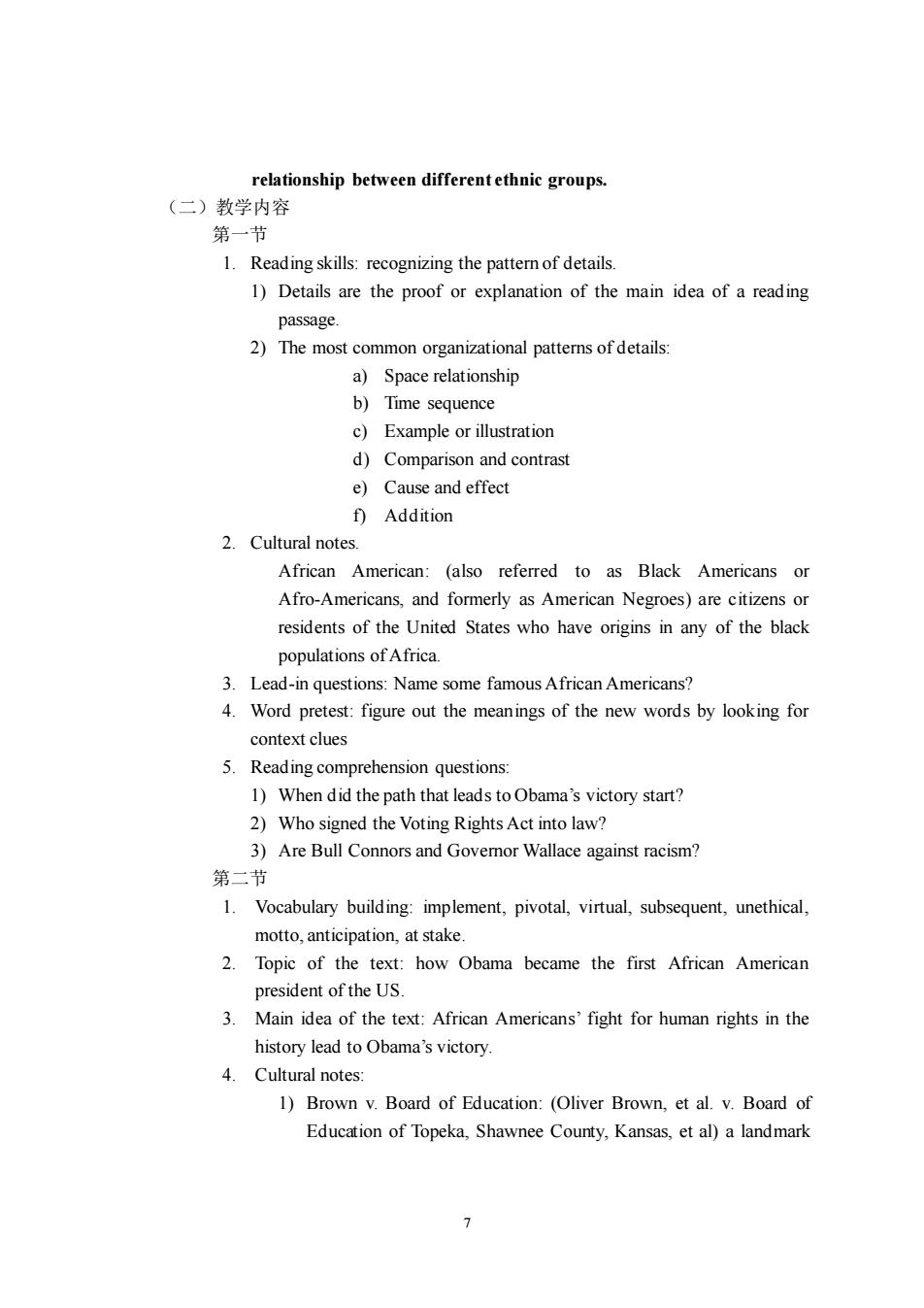
socialist values) (二)教学内容 第一节 1.Lead-in questions:Why do people work,apart from earning a living? 2.Word pretest:figure out the meanings of the new words by looking for context clues 3.Reading comprehension questions 1)What benefits can jobs and work bring to human beings except money? 2)What did freecitizens in ancient Greece expect to spend their lives in? 3)How did people in the Middle Ages think of work? 4)According to the author.what is the most attractive part about work? 5)What will the absence of work bring? 第二节 1.Vocabulary building:contentment,accumulate,contemplation,fulfill compulsion,exert,crave,unique,attributable to,substitute. 2. Topic of the text:why people work. 3.Main idea of the text:work provides not only the material things of life but also psychological well-being to people. 4.Discussion:Based on the reports about "model workers",discuss the connotation of the core socialist value"dedication"? (三)课后练习 Fast reading practice Further reading:Who makes it to the top? (四)教学方法与手段 Lecture and discussion. 第五章 Reading Skill &Unit 5 (一)目的与要求 After leamning this unit,studentsshould 1.understand the definition of details. 2.understandthe six types of pattemof details 3.be able to identify the pattern of details of a passage. 4.understand the connotation of the three core socialist values “harmony”,“equality”and“friendship”-from the perspective of the
6 socialist values). (二)教学内容 第一节 1. Lead-in questions: Why do people work, apart from earning a living? 2. Word pretest: figure out the meanings of the new words by looking for context clues 3. Reading comprehension questions: 1) What benefits can jobs and work bring to human beings except money? 2) What did free citizens in ancient Greece expect to spend their lives in? 3) How did people in the Middle Ages think of work? 4) According to the author, what is the most attractive part about work? 5) What will the absence of work bring? 第二节 1. Vocabulary building:contentment, accumulate, contemplation, fulfill, compulsion, exert, crave, unique, attributable to, substitute. 2. Topic of the text: why people work. 3. Main idea of the text:work provides not only the material things of life but also psychological well-being to people. 4. Discussion:Based on the reports about “model workers”, discuss the connotation of the core socialist value “dedication”? (三)课后练习 Fast reading practice. Further reading: Who makes it to the top? (四)教学方法与手段 Lecture and discussion. 第五章 Reading Skill &Unit 5 (一)目的与要求 After learning this unit, students should 1.understand the definition of details. 2.understandthe six types of pattern of details. 3.be able to identify the pattern of details of a passage. 4.understand the connotation of the three core socialist values - “harmony”, “equality” and “friendship” - from the perspective of the

relationship between different ethnic groups. (二)教学内容 第一节 1.Reading skills:recognizing the pattem of details 1)Details are the proof or explanation of the main idea of a reading passage. 2)The most common organizational patterns of details: a)Space relationship b)Time sequence c)Example or illustration d)Comparison and contrast e)Cause and effect f)Addition 2.Cultural notes. African American:(also referred to as Black Americans or Afro-Americans,and formerly as American Negroes)are citizens or residents of the United States who have origins in any of the black populations of Africa. 3.Lead-in questions:Name some famous African Americans? 4.Word pretest:figure out the meanings of the new words by looking for contextclues 5.Reading comprehension questions: 1)When did the path that leads toObama's victory start? 2)Who signed the Voting Rights Act into law? 3)Are Bull Connors and Govemor Wallace against racism? 第二节 1.Vocabulary building:implement,pivotal,virtual,subsequent,unethical. motto,anticipation,at stake. 2.Topic of the text:how Obama became the first African American president of the US. 3.Main idea of the text:African Americans'fight for human rights in the history lead to Obama's victory. 4.Cultural notes: 1)Brown v.Board of Education:(Oliver Brown,et al.v.Board of Education of Topeka,Shawnee County,Kansas,et al)a landmark
7 relationship between different ethnic groups. (二)教学内容 第一节 1. Reading skills: recognizing the pattern of details. 1) Details are the proof or explanation of the main idea of a reading passage. 2) The most common organizational patterns of details: a) Space relationship b) Time sequence c) Example or illustration d) Comparison and contrast e) Cause and effect f) Addition 2. Cultural notes. African American: (also referred to as Black Americans or Afro-Americans, and formerly as American Negroes) are citizens or residents of the United States who have origins in any of the black populations of Africa. 3. Lead-in questions: Name some famous African Americans? 4. Word pretest: figure out the meanings of the new words by looking for context clues 5. Reading comprehension questions: 1) When did the path that leads to Obama’s victory start? 2) Who signed the Voting Rights Act into law? 3) Are Bull Connors and Governor Wallace against racism? 第二节 1. Vocabulary building: implement, pivotal, virtual, subsequent, unethical, motto, anticipation, at stake. 2. Topic of the text: how Obama became the first African American president of the US. 3. Main idea of the text: African Americans’ fight for human rights in the history lead to Obama’s victory. 4. Cultural notes: 1) Brown v. Board of Education: (Oliver Brown, et al. v. Board of Education of Topeka, Shawnee County, Kansas, et al) a landmark